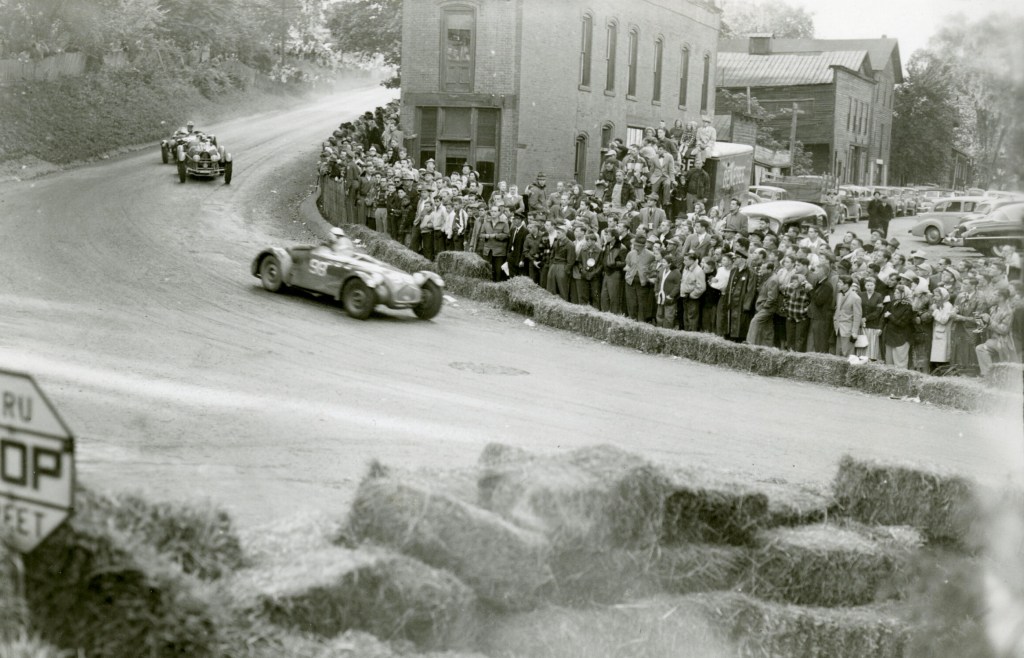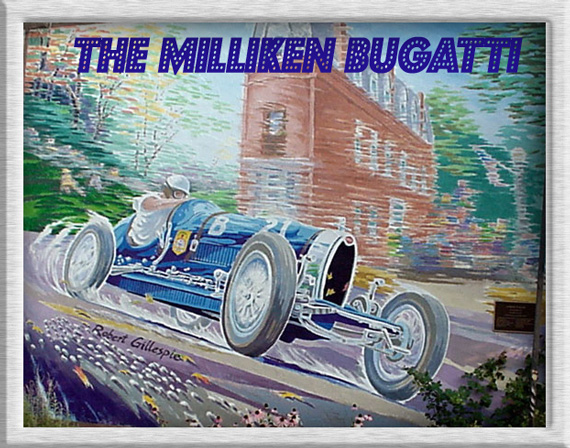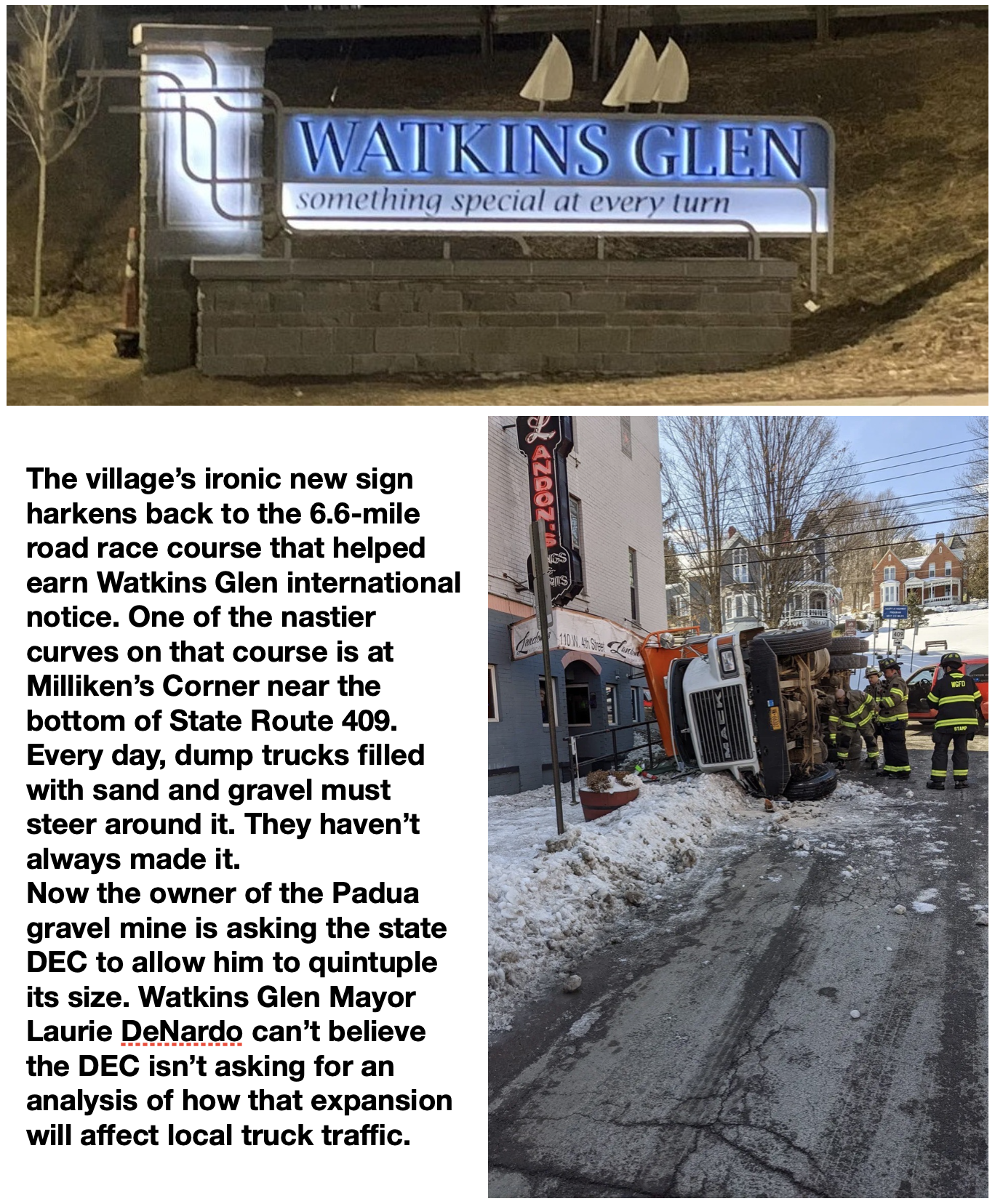WATKINS GLEN, Feb. 19, 2024 — What does a 1948 Bugatti 35A race car have in common with a dump truck loaded with sand and gravel?
Both have wrecked at Milliken’s Corner in Watkins Glen.

The near-90-degree turn at the bottom of the long hill down State Route 409 is nicknamed for Bill Milliken. He lost control on the nasty curve and flipped his Bugatti into a pile of straw bales during the 1948 Junior Prix. He walked away unhurt.
The Mack dump truck driver didn’t fare as well. He was sent to the hospital after rolling his load at the identical spot on Feb. 17, 2021, liberally spraying sand and gravel and busting the awning of Landon’s Pub and Pizza only 60 yards from the village’s busiest intersection.
The village’s ironic new signage promising “something special at every turn” harkens to the 6.6-mile famed road race course that has helped earn Watkins Glen international notice. Milliken’s Corner is one of the course’s most challenging curves because — as one writer put it — driver’s often “overcook their brakes” on the long downhill that leads into the sudden swerve.

Today dump trucks laden with sand and gravel extracted from the Padua Ridge gravel mine regularly negotiate the same turn.
The vast majority of trucks leaving the mine’s main entrance about a mile above Milliken’s Corner turn right onto Route 409. That takes them around a wide bend and then down a long straightaway before they hit the dangerous curve just before reaching State Route 14 in Watkins Glen.

Martin Wojcik, the owner of the 14.33-acre gravel mine that operates under the name It’s Greener Now Inc.(IGN), has been seeking the state’s permission to dramatically expand it since 2007.
In January, the state Department of Environmental Conservation announced that it had approved a 784-page draft Environmental Impact Statement for a plan to quintuple the size of the mine to 75.28 acres.
Voluminous as it is, the DEIS contains no analysis of how truck traffic would be affected by the proposed expansion. Nor does it provide detail on current truck traffic volumes.
Instead it dismisses the traiffic issue with the unsupported statement: “Truck traffic to and from the site will not be increased by the proposed expansion.”
The DEC’s approval of the DEIS without any meaningful section on traffic was not surprising. The scoping outline that the agency wrote in 2008 to spell out issues to be included in any future environmental impact statement omitted truck traffic and other salient environmental issues, including noise, dust and vibration.
Watkins Glen Mayor Laurie DeNardo said today the DEC should have required far more.

“The mere fact that this application for a permit extension isn’t exhaustive — to honor and protect our safety and quality of life, including a thorough traffic study — is incomprehensible,” DeNardo said.
The DEC announced last month in its Environmental Notice Bulletin that it was considering Wojcik’s plan even without any traffic analysis.
The ENB description of projected mining activity said: “The proposed (mine) expansion would result in the extraction of approximately 3,500,000 cubic yards of material for a duration of approximately 20 years.”
Assuming those numbers are accurate, large dump trucks laden with sand and gravel could be rounding the Milliken Corner more than once an hour — or even every half hour under the expansion plan.
Here’s how is possible to reach that conclusion:
— In 20 years, there are 7,300 days (20 times 365).
— The mine would need to extract an average of 479.5 cubic yards of material per day (3.5 million divided by 7,300).

— A cubic yard of sand and gravel typically weighs between 2,200 and 2,700 pounds. Assume a mid-range number of 2,500 pounds, or 1.25 tons, for the weight of one cubic yard of material.
— Large dump trucks can carry 14 tons, or 11.2 cubic yards, of material (14 divided by 1.25).
— That means an average of 42.8 trucks per day would be needed to carry 3.5 million cubic yards of material over 20 years, if they ran all day, every day (479.5 divided by 11.2).
— That works out to one large dump truck trip every 33 minutes (1440 minutes in a day divided by 42.8 truck trips per day).
— But if those trucks only ran during the mine’s “normal hours of operation” (6 am to 8 pm, Monday through Saturday, according to the DEIS), they would be running 98 hours a week rather than the 168 hours in a full week (58 percent of the time).

— If trucks ran only during normal hours of operation, It would require one large dump truck trip every 19 minutes (33 minutes times 0.58).
Of course, there are caveats.
Not every dump truck would travel during the mine’s normal hours of operation. And each truck would not necessarily turn right when it leaves the mine to head toward Milliken’s Corner and Watkins Glen. On the other hand, not every dump truck would necessarily have a 14-ton capacity. Some might carry only seven or eight tons, which would mean many more trips.
However, in almost any scenario, dozens of trucks laden with sand and gravel would have to safely negotiate Milliken’s Corner every day. Like Bill Milliken, they won’t necessarily make it.


The department of environmental conservation has decided to initiate this process by lying to the people of Schuyler county, Regarding either the duration of the permit (20 years) or the pace of mining (no greater operating hours, dust, noise, truck, traffic or runoff). It is mathematically impossible for both to be true. Zero trust in that agency to abide by their mission statement!
LikeLike